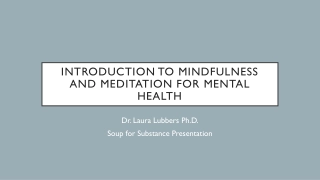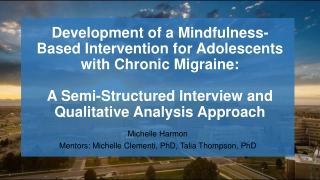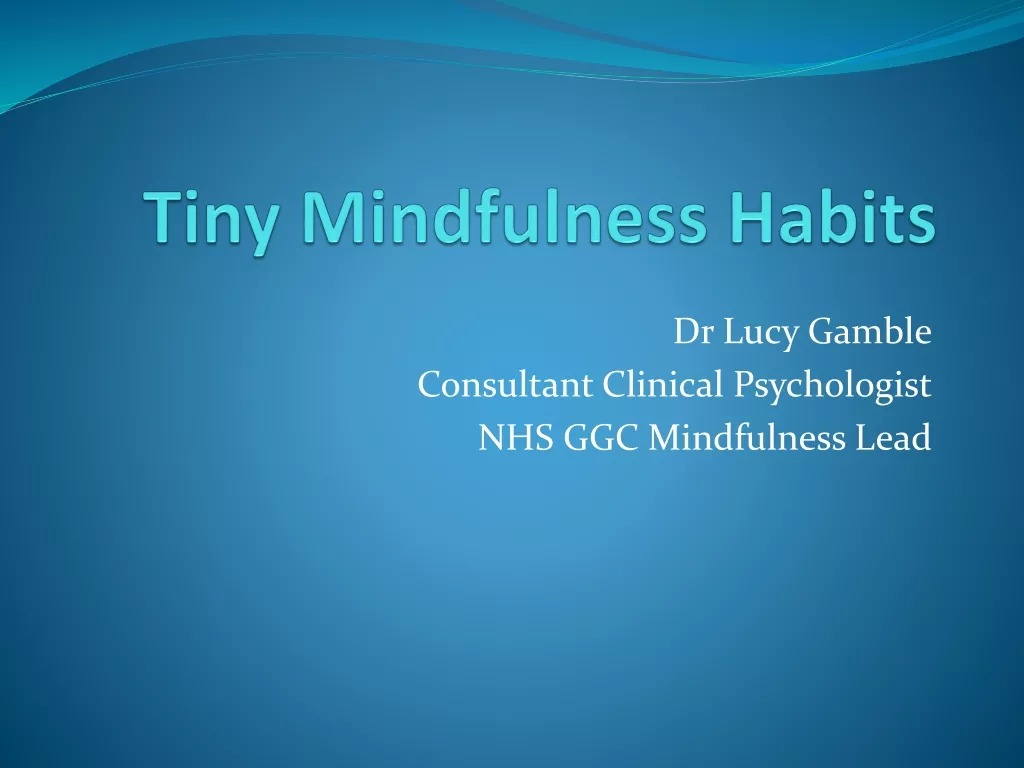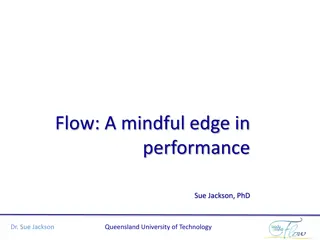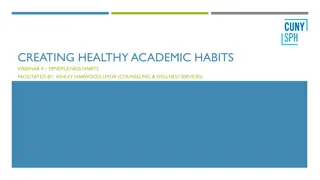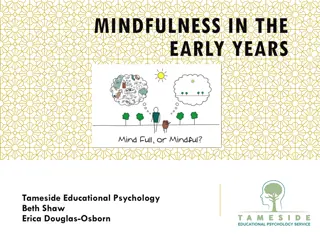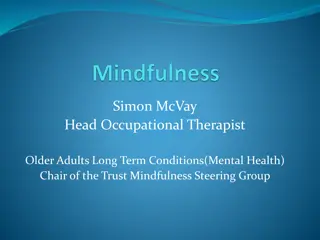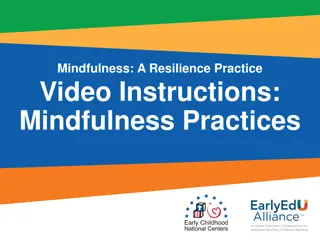Mindfulness Practices for Enhanced Well-being
Dive into the transformative world of mindfulness through a workshop led by Dr. Margaret McLean, focusing on understanding old and new brain interactions, core principles, and the essence of mindfulness. Learn to cultivate moment-to-moment awareness, respond mindfully, and embrace the seven elements of the mindfulness attitude. Discover the significance of sustained attention, non-judgmental observation, and the power of mindfulness in shaping our responses to life's experiences.
Download Presentation

Please find below an Image/Link to download the presentation.
The content on the website is provided AS IS for your information and personal use only. It may not be sold, licensed, or shared on other websites without obtaining consent from the author.If you encounter any issues during the download, it is possible that the publisher has removed the file from their server.
You are allowed to download the files provided on this website for personal or commercial use, subject to the condition that they are used lawfully. All files are the property of their respective owners.
The content on the website is provided AS IS for your information and personal use only. It may not be sold, licensed, or shared on other websites without obtaining consent from the author.
E N D
Presentation Transcript
Prevalence and Predictors of Prevalence and Predictors of Etravirine HIV HIV- -Positive Individuals Failing Second Positive Individuals Failing Second- -Line Antiretroviral Therapy in Antiretroviral Therapy in Uganda Etravirine Resistance Resistance in in Line Uganda Dr. Grace Namayanja Dr. Grace Namayanja Kaye 24 July 2019 24 July 2019 Kaye Namayanja-Kaye Grace,1Awor Anna C,1 Katureebe Cordelia,2 Nakaweesi Jane,3 Ssonko Michael,3 Namusoke Magongo Eleanor,2 Sewanyana Isaac,5 Nansumba Hellen5, Adler Michelle,1 Watera Christine,5 Jacobson Kathleen,1 Namale Alice,1 Raizes Elliot,6 Ssali Francis,7 1.Centers for Disease Control and Prevention, Kampala, Uganda, 2.Ministry of Health AIDS Control Program, Kampala, Uganda, 3.Mildmay Uganda, Kampala, Uganda, 4. Uganda Virus Research Institute, Entebbe, Uganda, 5. Central Public Health Laboratories, Kampala, Uganda, 6.Centers for Disease Control and Prevention, Atlanta USA, 7.Joint Clinical Research Center, Kampala Uganda
Prevalence Prevalence and Predictors of and Predictors of Etravirine Failing Second Failing Second- -Line Antiretroviral Therapy in Uganda Line Antiretroviral Therapy in Uganda Background Background WHO recommends Etravirine (ETR) as one of the three backbone drugs for empiric third-line antiretroviral therapy (ART) in absence of genotyping The 2016 Uganda HIV treatment guidelines recommend HIV drug resistance (HIVDR) genotyping for patients failing protease inhibitors (second line) Beginning June 2017, Uganda began routine HIVDR genotyping for all PLHIV failing second-line regimens (defined as two successive non-suppressed viral load results, done 6 months apart) Individuals failing second-line therapy may have resistance mutations hindering use of ETR for effective third line This analysis assesses prevalence and predictors of ETR resistance in HIV patients failing second- line therapy in Uganda Etravirine Resistance Resistance in in HIV HIV- -Positive Individuals Positive Individuals Figure 1: Number of HIVDR samples from 100 Districts in Uganda Methods Methods Dried blood spots (DBS) from rural facilities and plasma from peri-urban facilities were sent to the Central Public Health Laboratory for routine viral load (VL) testing Repeat DBS and Plasma non-suppressed viral load samples were sent to the Uganda Virus Research Institute and Joint Clinical Research Center respectively Genotype results were used to determine third-line regimens by the National Third Line ART Committee A retrospective cross-sectional review of de-identified data for patients failing second line from June 2017 to November 2018 was conducted ETR resistance-associated mutations (RAMs) were scored using the Tibotec genotypic weighting scale, an ETR Score of (ETR-S) 2.5 was considered ETR resistance
Figure Figure 2: November 2018 November 2018 2: Prevalence of Prevalence of Etravirine Etravirine Resistance in Uganda from June 2017 to Resistance in Uganda from June 2017 to Prevalence and Predictors of Prevalence and Predictors of Etravirine HIV HIV- -Positive Individuals Failing Second Positive Individuals Failing Second- -Line Antiretroviral Therapy in Uganda Antiretroviral Therapy in Uganda Results Results Etravirine Resistance Resistance in Line in Genotype Genotype results Two excluded for missing data 43% females; 25% children < 15 years results were were reviewed reviewed from from 267 267 clients clients failing failing second second line line Non Non- -nucleoside nucleoside reverse resistance resistance NNRTI mutations found in 224 (84.5%) clients No significant difference in ART duration between first line NVP vs EFV exposure (4.8 vs 4.5 years; p=0.512) reverse transcriptase transcriptase inhibitor inhibitor (NNRTI) (NNRTI) exposure exposure and and Table 1: Predictors of Table 1: Predictors of Etravirine from June 2017 to November 2018 from June 2017 to November 2018 Etravirine Resistance from 100 districts in Uganda Resistance from 100 districts in Uganda ETR ETR RAMs RAMs: : Found Mean ETR-S = 1.5 (SD 0.66); no significant difference between adults and children (1.49 vs 1.64; p=0.477). Almost all (168; 98.5%) had previous NNRTI exposure; Mean ETR-S=1.7 for NVP vs Mean ETR-S=1.1 for EFV (p=0.003). Most common mutations: G190A (26%), A98G (17%), and Y181C (17%). Found in in 171 171 ( (64 64% %) ) clients clients ETR ETR resistance resistance An ETR-S score of 2.5 (signifying ETR resistance) was found in 89 (33.6%) clients. No significant difference was found in ETR-resistance based on sex, age, or NNRTI exposure (NVP vs EFV).
Conclusions and Recommendations Conclusions and Recommendations Conclusions One-third of clients failing second line ART are already resistant to ETR Neither sex, age, nor prior NNRTI exposure were significant predictors of Etravirine resistance NVP exposure is correlated significantly with higher mean ETR-S score but not with ETR resistance Recommendations Recommendations Given the high prevalence of ETR resistance among clients failing second line in Uganda, ongoing investment in HIVDR testing for this population to guide third line regimen selection is warranted Other resource-limited countries may consider investment in HIVDR for those failing second line


